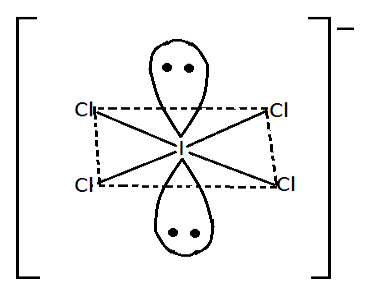
In $ICl_4^ - $ , the shape is square planar, the number of bond pair-lone pair repulsion at ${90^ \circ }$ are:
$A.$ $6$
$B.$ $8$
$C.$ $12$
$D.$ $4$
Answer
526.8k+ views
Hint:We can predict the number of bond pair-lone pair repulsions at${90^ \circ }$ by drawing its structure. The shape of $ICl_4^ - $ is square planar because it has four bond pairs and lone pairs. The geometry is octahedral.
Complete step-by-step answer:Before solving the question we have to look at the structure to determine their number of bond pair-lone pairs.
Now, the structure of $ICl_4^ - $ is,

Iodine $\left( I \right)$ has $7$ electron it its valence shell in $ICl_4^ - $eight electron participate in formation of compound
Shape of $ICl_4^ - $is square planar. Since its geometry is octahedral, lone pairs reside above and below the square planar. In $ICl_4^ - $each lone pair interacts with the $4$ bond pair.
So, Number of bond pair-lone pair repulsion=Total number of lone pairs multiplied by number of bond pairs by which they interact. We have two lone pairs and four bond pairs
Number of bond pairs-lone pairs repulsion$ = 2 \times 4$
$ = 8$
Thus, there is $8$ bond pairs-lone pairs repulsion at ${90^ \circ }$ . So, the correct option is $B.$
Note: Valence Shell Electron Pair Repulsion Theory $\left( {VSEPR} \right)$ .This is a very useful theory to predict the geometry or shape of a number of polyatomic molecules or ions on a non-transition element. This theory says that shapes of a species depend on the number of and nature of electron pairs surrounding the central atom of a species.
Table summarizes the relationship between the number of electron pairs that are bond pairs and lone pairs and the shape or geometry.
Complete step-by-step answer:Before solving the question we have to look at the structure to determine their number of bond pair-lone pairs.
Now, the structure of $ICl_4^ - $ is,

Iodine $\left( I \right)$ has $7$ electron it its valence shell in $ICl_4^ - $eight electron participate in formation of compound
Shape of $ICl_4^ - $is square planar. Since its geometry is octahedral, lone pairs reside above and below the square planar. In $ICl_4^ - $each lone pair interacts with the $4$ bond pair.
So, Number of bond pair-lone pair repulsion=Total number of lone pairs multiplied by number of bond pairs by which they interact. We have two lone pairs and four bond pairs
Number of bond pairs-lone pairs repulsion$ = 2 \times 4$
$ = 8$
Thus, there is $8$ bond pairs-lone pairs repulsion at ${90^ \circ }$ . So, the correct option is $B.$
Note: Valence Shell Electron Pair Repulsion Theory $\left( {VSEPR} \right)$ .This is a very useful theory to predict the geometry or shape of a number of polyatomic molecules or ions on a non-transition element. This theory says that shapes of a species depend on the number of and nature of electron pairs surrounding the central atom of a species.
Table summarizes the relationship between the number of electron pairs that are bond pairs and lone pairs and the shape or geometry.
| Total number of electron pairs | Shape |
| 2 | Linear |
| 3 | Trigonal planar |
| 4 | Tetrahedral |
| 5 | Trigonal bipyramidal |
| 6 | Octahedral |
| 7 | Pentagonal bipyramidal |
Recently Updated Pages
Master Class 12 Business Studies: Engaging Questions & Answers for Success

Master Class 12 Economics: Engaging Questions & Answers for Success

Master Class 12 English: Engaging Questions & Answers for Success

Master Class 12 Maths: Engaging Questions & Answers for Success

Master Class 12 Social Science: Engaging Questions & Answers for Success

Master Class 12 Chemistry: Engaging Questions & Answers for Success

Trending doubts
What is meant by exothermic and endothermic reactions class 11 chemistry CBSE

Which animal has three hearts class 11 biology CBSE

10 examples of friction in our daily life

One Metric ton is equal to kg A 10000 B 1000 C 100 class 11 physics CBSE

1 Quintal is equal to a 110 kg b 10 kg c 100kg d 1000 class 11 physics CBSE

Difference Between Prokaryotic Cells and Eukaryotic Cells




